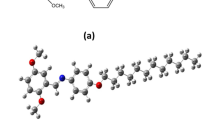Abstract
In the present work, we have calculated the electro-optical effect of the I52 (4-Ethyl-2-fluoro-4′-[2-(4-pentyl-cyclohexyl)-ethyl]-biphenyl) liquid crystal (LC) molecules under the influence of an external electric field in the THz frequency region. The electro-optical calculation has been performed with the help of a theoretical model which is developed for the organic compounds (liquid crystal), and also suitable for the terahertz (THz) device application. The theoretical model gives the electro-optical properties and correlates with experimental evidence. The birefringence, order parameter, refractive index, dipolar strength, and HOMO-LUMO of the I52 molecules have been calculated theoretically. By increasing the electric field on the molecules, the order parameter and birefringence show positive as well as negative values. The I52 LC molecule behaves as an insulator due to having a large bandgap (5.08 eV).
Graphical abstract







Similar content being viewed by others
Data availability
The datasets generated during and analyzed during the current study are available from the corresponding author on reasonable request.
References
Vieweg N, Koch M (2010) Terahertz properties of liquid crystals with negative dielectric anisotropy. Appl. Opt. 49:5764–5767. https://doi.org/10.1364/AO.49.005764
Dunmur D, Hitchen D, Xi-jun H (1986) The physical and molecular properties of some nematic fluorobiphenylalkanes. Mol. Cryst. Liq. Cryst. 140:303–318. https://doi.org/10.1080/00268948608080160
Dziaduszek J, Dabrowski R, Ziołek A, Gauza S, Wu S (2009) Syntheses and mesomorphic properties of laterally fluorinatedphenyl isothiocyanatotolanes and their high birefringent mixtures. Opto-Electron Rev 17:20–24. https://doi.org/10.2478/s11772-008-0031-2
Finkenzeller U, Geelhaar T, Weber G, Pohl L (1989) Liquid-crystalline reference compounds. Liq. Cryst. 5:313–321. https://doi.org/10.1080/02678298908026372
Tsai T-R, Chen C-Y, Pan R-P, Pan C-L, Zhang X-C (2004) Electrically controlled room temperature terahertz phase shifter with liquid crystal. IEEE micr wirel co 14:77–79. https://doi.org/10.1109/LMWC.2003.819958
Haase W, Potzsch D (1977) Light transmission experiments with nematic liquid crystals showing positive and negative dielectric anisotropy. Mol. Cryst. Liq. Cryst. 38:77–85. https://doi.org/10.1080/15421407708084376
Reiffenrath V, Krause J, Plach H, Weber G (1989) New liquid-crystalline compounds with negative dielectric anisotropy. Liq. Cryst. 5:159–170. https://doi.org/10.1080/02678298908026359
Balkwill P, Bishop D, Pearson A, Sage I (1985) Fluorination in nematic systems. Mol Cryst Liq Cryst 123:1–13. https://doi.org/10.1080/00268948508074765
Frisch MJ, Trucks GW, Schlegel HB, Scuseria GE, Robb MA, Cheeseman JR, Scalman G et al. (2010) Gaussian,Inc., Wallingford CT, Gaussian 09. https://gaussian.com/g09citation/
Becke A (1993) Density-functional thermochemistry. III. The role of exact exchange. J. Chem. Phys. 98:5648. https://doi.org/10.1063/1.464913
Lee C, Yang W, Parr RG (1988) Development of the Colle-Salvetti correlation-energy formula into a functional of the electron density. Phys. Rev. B 37:785. https://doi.org/10.1103/PhysRevB.37.785
Hay PJ, Wadt WR (1985) Ab initio effective core potentials for molecular calculations. Potentials for the transition metal atoms Sc to Hg. J Chem Phys 82:270–283. https://doi.org/10.1063/1.448799
Wang Y, Wang F, Li J, Huang Z, Liang S, Zhou J (2017) Molecular structure and electronic properties of triolein molecule under an external electric field related to streamer initiation and propagation. Energies 10:510. https://doi.org/10.3390/en10040510
Kumar N, Singh P, Upadhyay P, Chaudhary S et al (2020) Odd–even effect of 7O. m liquid crystal compound series studied under the effect of the electric field by density functional theory (DFT) methods. Eur Phys J Plus 135:388. https://doi.org/10.1140/epjp/s13360-020-00386-9
Kumar N, Singh P, Thapa KB, Kumar D (2020) Molecular spectroscopy and adverse optical properties of N-(p-hexyloxy-benzylidene)–p-toluidine (HBT) liquid crystal molecule studied by DFT methodology. IOP Sci Notes 1:015202. https://doi.org/10.1088/2633-1357/ab7f83
Dennin M (2000) Direct observation of a twist mode in electroconvection. Phys. Rev. E 62:6780. https://doi.org/10.1103/physreve.62.6780
Acknowledgments
N. Kumar is very thankful to the University Grants Commission (UGC) New Delhi for providing fellowship to this work (NFSC). P. Singh is grateful to UGC for providing a non-net companionship. The authors are very thankful to Dr. Anakuthil Anoop Ayyappan (IIT, Kharagpur, WB) for providing computational help.
Author information
Authors and Affiliations
Contributions
Theoretical modeling and preparation of the manuscript has been done by Narinder Kumar and Pawan Singh provided the analysis of the theoretical model, while the other co-authors, Dr. Khem B. Thapa, Dr. Pranav Upadhyay, and Dr. Devesh Kumar, discussed the results and check the manuscript.
Corresponding author
Ethics declarations
Conflicts of interest
The authors declare that they have no conflicts of interest.
Additional information
Publisher’s note
Springer Nature remains neutral with regard to jurisdictional claims in published maps and institutional affiliations.
Supplementary Information
ESM 1
(DOCX 237 kb)
Rights and permissions
About this article
Cite this article
Kumar, N., Singh, P., Thapa, K.B. et al. Molecular spectroscopy and electro-optical effect of I52 liquid crystal molecules studied under the influence of an external electric field (THz): a theoretical approach. J Mol Model 27, 11 (2021). https://doi.org/10.1007/s00894-020-04649-1
Received:
Accepted:
Published:
DOI: https://doi.org/10.1007/s00894-020-04649-1




